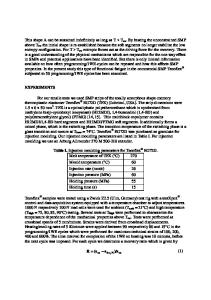Design and Realization of Biomedical Devices Based on Shape Memory Polymers
- PDF / 3,726,813 Bytes
- 13 Pages / 612 x 792 pts (letter) Page_size
- 60 Downloads / 333 Views
1190-NN06-01
Design and Realization of Biomedical Devices Based on Shape Memory Polymers Duncan J. Maitland1,2, Ward Small IV2, Pooja Singhal1, Wonjun Hwang1, Jennifer N. Rodriguez1 Fred Clubb3, and Thomas S. Wilson2 1
Biomedical Engineering Department, Texas A&M University, 3120 TAMU, College Station, TX 77843, U.S.A. 2 Physical and Life Sciences Directorate, Lawrence Livermore National Laboratory, Livermore, CA 94550, U.S.A. 3 College of Veterinary Medicine, Texas A&M University, College Station, TX 77843, U.S.A.
ABSTRACT Our experience with shape memory polymers (SMP) began with a project to develop an embolic coil release actuator in 1996. This was the first known SMP device to enter human trials. Recent progress with the SMP devices include multiple device applications (stroke treatments, stents, other interventional devices), functional animal studies, synthesis and characterization of new SMP materials, in vivo and in vitro biocompatibility studies and devicetissue interactions for the laser, resistive, or magnetic-field activated actuators. We describe several of our applied SMP devices.
INTRODUCTION Shape memory polymer (SMP) is a material that will have a significant impact on clinical medicine. SMP is a relatively new material that is similar to shape memory alloy (SMA) in its ability to actuate from an initial deformed shape into a second, pre-determined shape. SMP and SMA have material property, fabrication, biocompatibility and cost trade-offs for medical applications. SMP is new to medical applications and has superior shape and volume changing capabilities. The first SMP medical device was just recently approved in March 2009 by the U.S. Food and Drug Administration[1]. SMPs are a class of polymeric materials that can be formed into a specific primary shape, reformed into a stable secondary shape, and then controllably actuated to recover the primary shape. A review of SMP basics and representative polymers was given by Lendlein[2]. Such behavior has been reported in a wide variety of polymers including polyisoprene, styrenebutadiene copolymers[3], segmented polyurethanes[4] and their ionomers[5], copolyesters[3,6], ethylene-vinylacetate copolymers[5], polyacrylamide gels with small amounts of triphenylmethane leucohydroxide[7], and polyacrylic acid[8]. Although there is wide chemical variation in these materials, they can be grouped into categories with high physical similarity based on the method of actuation, which can be achieved thermally, through photo-induced reaction, or by changing the chemical environment[7]. For the SMPs that are actuated thermally, raising the temperature of the polymer above the glass transition temperature (Tg) results in a decrease in the elastic modulus from that of the glassy state (~ 109 Pa) to that of an elastomer (~ 106 to 107 Pa). Upon cooling, the original modulus is nearly completely recovered and the primary form is stabilized. While other classes of thermally activated shape memory materials
have been developed, SMAs[9] and shape memory ceramics[10] bei
Data Loading...











